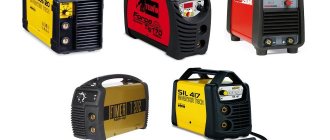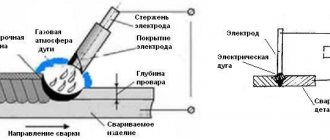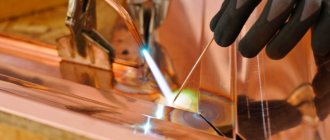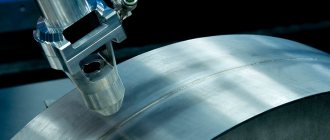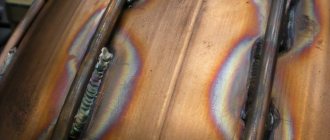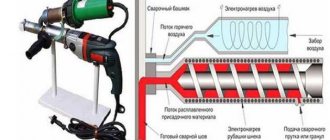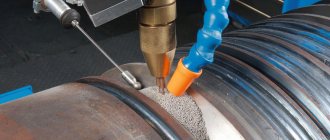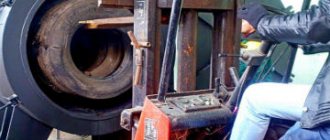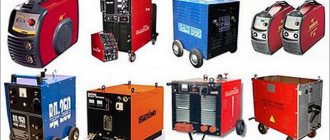Pulsed welding is based on the traditional electric arc method, but the current is supplied to the poles in a pulsed mode. What is it from an applied point of view - a seam formed by even drops of melt. The pulse welding mode allows you to control the process of pool formation, significantly expands the capabilities of the traditional arc method, is used for dissimilar metals, and forms a diffuse joint.
Features of pulse welding
This type of welding is capable of joining such capricious metals as copper alloys, steel and many other non-ferrous alloys, including aluminum. Pulse welding is excellent for complex butt welds when joining metal workpieces with thick edges.
Historically, pulsed welding was invented and developed as a competitive method to electric arc technology, which has certain disadvantages in terms of productivity and weld quality.
The essence of the process
The principle of pulse welding.
In short, this is a process of sequential melting of the metal of the workpiece at certain points with the next stage in the form of coating.
The main element of this process is the so-called low-power pilot arc, which continues to operate in stops between repeating pulses and transmits the pulse current only partially.
This arc has virtually no effect on the metal between pulses; it burns perfectly and steadily in space. The second state of the same arc is pulsed, which melts the metal at the points of application.
The ratio of currents from the arc in different states - pulsed and standby - must be correct, which can speed up welding and improve the quality of the seam.
The possibilities of classical gas-shielded arc welding are greatly expanded if the metal is melted under the influence of a pulsed arc.
Its main feature is a special mode for turning on and off the arc, which is determined by the program depending on the nature of the metals of the workpieces being connected, the thickness of their edges and the position of the seams in space.
Short pulses are produced using the energy of a special battery, which is pre-charged from an electrical circuit. The main technological feature and advantage of the method is the ability of pulse welding to form permanent joints of metals with completely different compositions.
Equipment for pulse welding requires special equipment - this is a special specialized pulse welding machine with certain consumables. The pulse machine generates dosed welding pulses.
Consumable materials include various types of electrodes - consumable and non-consumable.
The pulse welder includes the following elements:
- low frequency rectifier;
- another high-frequency rectifier;
- welding inverter device;
- transformer;
- electronic control unit - plateau;
- working shunts.
Electrical diagram of a pulse welding device.
The two pulse welding methods are determined by the choice and use of electrodes:
- using non-consumable electrodes;
- using consumable electrodes, eliminating the disadvantage of the process in the form of splashing drops of molten metal.
One way or another, this is a controlled, repeating process of transferring molten consumable metal in a protective gas environment.
Here's how it happens:
- A drop of molten metal from the consumable wire is separated and moved to the workpiece under the influence of a powerful impulse.
- Immediately after this, the strength of the welding current drops to a level that can only support the arc - the arc becomes “standby”, of low power.
- The process of cooling the metal in the weld pool begins instantly.
- An exact repetition of the same cycle of droplet transfer under a pulse begins, with a drop in current, cooling, etc.
From the point of view of the electrical component of the pulse welding process, the device uses the transformation of mains voltage into rectified direct voltage, after which it turns into voltage with a high frequency.
Peak current
Or the main current for arc welding without a pulse is the main welding parameter that forms the weld pool and weld seam. When welding with a pulsed arc, this is the upper limit of the welding current, which also forms the weld seam. Typically has a range from 5–15 Amps to the maximum welding current of the machine.
Advice. It is better to set the starting current to a higher peak (main) current of 10–20 Amps in order to quickly form a weld pool without further overheating of the base metal. It is better to set the current decay time from 1.5 to 2.0 seconds, so as not to heat the metal for a long time and not get burned.
Technical nuances
Before starting work, the energy receiver must be connected to the power supply to charge it to the required level. Pulse welding itself takes very little time, since it uses the energy stored in the receiver. This kind of welding can be done with your own hands; it is not at all overly complicated.
With this method, the unpleasant phenomenon of splashing droplets of molten metal is perfectly controlled and minimized. There is an excellent opportunity to produce high-quality welds almost at home.
Seams are formed due to the melting of individual portions of metal followed by coating.
The most important point is the correct setting of the pulse and pilot arc modes. If the mode is correct, the process will go quickly, correctly and, most importantly, safely, without any craters in critical joint areas.
Pulsed DC welding
The rigidity of the regime is a technological feature of this method. It's all about the pulse duration. If you change it, all welding parameters will change.
One of the important advantages is the ability to control and minimize metal crystallization. You can change the shape of the weld pool. Additionally, the risk of weld deformation can be controlled and reduced.
This method is often used to join metal with edge thicknesses greater than 3 mm.
Advantages of a homemade device
In addition to the price, a homemade pulse welding machine has many other advantages over models sold in stores. The first advantage is low current consumption. If you plug an ordinary device from a store into a household outlet at your dacha and weld a gate, for example, you will soon receive electricity bills and be unpleasantly surprised. In addition, connecting such a device to a household outlet is simply dangerous; the machines may not withstand such power.
Don’t forget about the dimensions of purchased devices. It is simply impossible to calmly carry them in your hands from place to place. In factories, welders simply use very long wires so as not to move such a device around the workshop. However, the price for such wires is very high, and we don't think you'll want to spend an extra $100 on cables. But the homemade device weighs little and can be easily moved.
Also, purchased devices have their own production capabilities, and they rarely exceed 80%. And often they are at around 50%. This means that such a device simply cannot reveal its full potential. This happens because a large and technically complex welder gets very hot and takes a long time to cool down. For this reason, you will also not be able to cook for more than 2-3 minutes at a time.
A homemade welder assembled according to our diagrams does not have such disadvantages. There are no reactive currents in it, so almost all electrical energy is used. You can easily connect such a welder to a home outlet and not worry about electricity bills and possible operating time. After all, the power of our homemade device is only slightly greater than the power of a regular iron.
Classification of species
Pulse welding is divided into four types:
- capacitor using devices with a huge range of current. Excellent for welding aluminum parts;
- rechargeable, which uses devices with alkaline batteries, copes well with short circuits in the network;
- inertial using the kinetic energy of a powerful flywheel;
- electromagnetic with the production of mechanical energy using a magnetic field. The elements are attached by magnetic forces combined with high pressure.
MIG + 4T (SYN ON)
The second mode we will consider is MIG + 4T (SYN ON). It has a similar menu, only in 4T mode the crater filling current functionality is added.
| Display symbol | Decoding the meaning | Adjustment range | Unit |
| I2 | Crater filling current | 25–200 | A |
Crater filling current is a parameter that allows you to set the required wire feed speed to complete the welding process without creating a crater.
The crater filling voltage is adjusted automatically.
Recommendation: For high-quality crater filling in 4T mode, the torch button must be pressed until the arc goes out.
Algorithm of actions
This is one of the best types of welding overall. There is no spattering, no lack of fusion is formed, you can cook in any position, electrodes are used very sparingly. The seams are formed of exceptional quality without any burns.
Capacitor welding scheme.
The principle of operation of a welding inverter in combination with pulse technology is as follows: transfer of the electrode metal into the weld pool while simultaneously regulating the current.
It all starts with the formation of a drop of metal at the end of the electrode, which, when the current increases, enters the weld pool. Now this hot moment should be replaced by a cold stage with the cooling of the metal. This can happen many times.
The electrode wire must be well heated. This is especially important at low current values.
A pulse welding machine is an extremely versatile device: it can also be used in a gas environment to join metal parts of very different thicknesses and configurations.
These devices are very easy to use with clear adjustments for proper and fine tuning. They are usually equipped with good software support, which makes them even more effective in all respects.
MIG + 4TL (SYN OFF)
The fifth mode MIG + 4TL (SYN OFF) has a similar menu, where there is the functionality of the starting welding voltage and crater filling current. The remaining settings are similar to MIG + 2T.
| Display symbol | Decoding the meaning | Adjustment range | Unit |
| U1 | Starting welding voltage | -2.0 to +2.0 | IN |
| I2 | Crater filling current | 25–200 | A |
Starting welding voltage is a parameter necessary for high-quality melting of the welding wire at the start of welding.
Allows you to adjust the voltage so that the wire melts and forms a welding seam of the required width and penetration depth.
The main advantages of the method
Advantages of pulse welding:
- The first thing is the excellent quality of the weld. Let us immediately note that pulse devices are very expensive things. But they are worth it and will definitely pay off all costs in the future.
- Pulse welds everything from steel to aluminum.
- A minimum of additional tools and consumables are required.
- No metal spattering.
- There are no burns or failures of fusion.
- Ability to control the arc.
- Excellent ability to control the metal transfer process.
- Economical consumption of materials, including welding wire and electrodes.
- Easy seam cleaning at the end.
- Easy to perform even for beginners.
Drawing of a pulse welding device.
Today, this method has only one competitor in popularity and efficiency - semi-automatic welding. It is characterized by high productivity and, importantly, process continuity.
But a serious drawback is metal spattering, which results in the loss of up to 30% of the material. In addition to losses, these spatters must be cleaned after welding, which is very difficult and spoils the appearance of the weld. Pulse welding eliminates such a problem.
The main area of application of the method is the installation of pipelines of the most critical type, where the strength of the seam with a firmly formed back bead without finishing stripping is especially important.
This method has only two disadvantages:
- it is not suitable for large welding areas;
- serious cooling of the inductor is always necessary.
MIG + 4T (SYN OFF)
The third mode is MIG + 4T (SYN OFF). It has a similar menu, only in addition to the previously listed parameters, this mode contains the crater filling voltage functionality.
| Display symbol | Decoding the meaning | Adjustment range | Unit |
| U2 | Crater filling voltage | -0.2 to +2.0 | IN |
Crater filling voltage is a parameter necessary for high-quality melting of the welding wire at the end of welding.
DIY pulse welder
The design of the welding machine makes it possible to make it at home for domestic use. The components are easy to buy, there are no problems here. But we must not forget about some nuances.
A special focus is on transistors, because they break down and fail most quickly. Don't skimp on them, but buy four high-quality transistors.
Before you start working, you need to think about and calculate the strength of the welding current and the power of the device. There are a huge number of examples with similar calculations on the Internet; they can help in developing the right solution.
MIG + 4TL (SYN ON)
The fourth mode is MIG + 4TL (SYN ON). In general, this is a mode of complete control over welding characteristics from the beginning of welding to the end of the process.
This mode starts when you press and hold the burner button, the process of setting the starting current and voltage occurs. Next, when the button is released, the device aligns the parameters from the starting ones to the working ones - the welding process begins.
When welding is completed, by pressing and holding the torch button, the characteristics decrease from working to final - to the crater filling voltage and crater filling current.
Recommendation: the welder regulates the duration of the starting current and crater filling himself by holding the torch button for the required number of seconds.
The mode has a similar menu; in addition to the previously listed parameters, this mode has the functionality of starting welding current.
| Display symbol | Decoding the meaning | Adjustment range | Unit |
| I1 | Starting welding current | 25–200 | A |
Starting welding current is a parameter that allows you to set the welding current at the beginning of welding.
Allows you to uniformly heat the metal edges being welded to obtain a weld pool. It is of particular importance when welding thick metals and when welding aluminum alloys, where heating of the edges without unnecessary wire surfacing is required. Please note that the starting voltage will be adjusted automatically.
